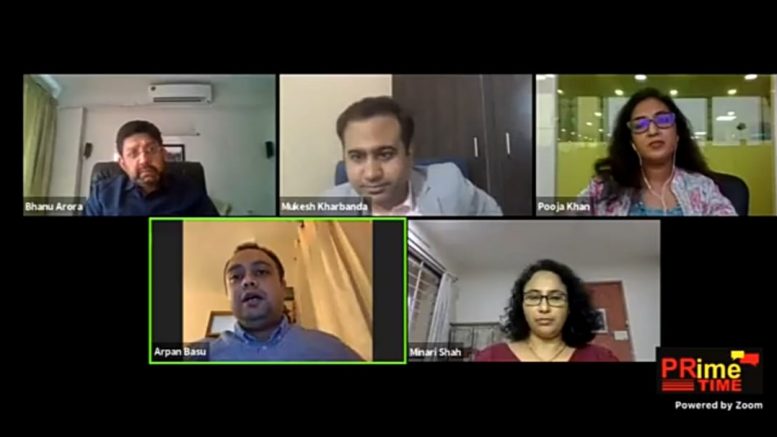Looking at the regional marketing scene in India, the regional segment has off late, become a space that brands just can’t afford to ignore.
We must remember our PM’s clarion call for becoming ‘vocal for local’. Will this usher in a new era? Will Regional PR players become the game changers in the near future? We are aware that India is a land of diverse cultures, where so many dialects exist, and people have varied preferences and tastes. In such an environment, we have seen that the need for regional PR has expanded, and the good news is that – Regional PR seems to be emerging stronger from the crisis!
Four communication leaders shared their thoughts on media outreach in Regional India, in the discussion on – ‘The new normal a blessing in disguise for Regional PR’, that was moderated by Mukesh Kharbanda, Founder and Managing Director, Fuzion PR as he interacted with Arpan Basu, Director Communications at Coca-Cola India & South West Asia; Bhanu Arora, Head Corporate Affairs & Communications, METRO Cash & Carry India; Minari Shah, Director – Public Relations at Amazon India and Pooja Khan, Head – Corporate Communications, Panasonic India.
Where does Regional PR fit in?
How important is Regional PR for brands? And can we foresee any substantial changes due to COVID? It is all driven by the business goals, and if your business is aligned to reach the rural masses, you cannot do without Regional PR, asserted Arpan. The rural ground is a great opportunity and you cannot ignore it. In the IRS survey, the publications topping the list are regional while English publications are ranked 9th or 10th pointed out Bhanu, and added that it’s loud and clear that Regional PR has to be there! The aim of Amazon as a company is to bring 100 million people on its platform and this cannot happen without local support, shared Minari. Firmly of the opinion that Regional PR has a strong role to play was Pooja for “there’s not one India, but many different Indias”. Every 50 kms the dialect changes, so you have to go regional. With over two decades of working in PR, she asserted that Regional PR has also been a significant part of the brand strategy, and this is definitely not the new normal, it is normal!
Share of the regional
Mukesh shared a survey done, where it revealed that the regional pie was 18 to 20% of the revenue, while 80% gets generated beyond metros. Why is this state of affairs? To reach out to customers across the different corners of the country, Pooja felt that you have to reach out to Regional PR. Her strong recommendation was – dive deeper into the regional. Having a strong presence in South India, METRO Cash & Carry, the focus is on ‘local’. “As a brand, we have to reach out to locals. We, as communicators have to find out creative plans to communicate to locals about the importance of your brand”, narrated Bhanu. As a corporate communication professional, you have to convince the management about importance of regional PR. In TV and OTT channels we see conversion of content to regional languages too.
Do Public Affairs engage local governments?
An important differentiation is that policies for local regions, differ from national level policies. For instance, look at how each government is dealing with COVID currently – the way Delhi is dealing with it is different to the way UP or West Bengal is doing. People are understanding this, said Bhanu and are reaching out to regional stakeholders.
Amazon believes they have to be in the market before the demands hit. Last year, Amazon conducted a campaign during Diwali – “Festive Yatra” which focused on how everything can be found on Amazon that had a huge impact on regional PR, disclosed Minari. The plan was to cover five cities, but it got extended to thirteen cities in a wider time-frame of thirty-five days. So, the clear understanding for brands is that – you have to reach out.
The media landscape had evolved and so has the business landscape and today, we are talking of becoming hyper-local, said Arpan. Traditional media and even modes of communication have evolved, so “the need of the hour is – regionalised, personalised communication”.
Parameters to make the purchase decision
With brand Coca Cola being available all across the country, Arpan summed it up by two words – availability and affordability. It’s value for money and ease of accessibility, according to Pooja; there’s unprecedented demand and brands have to be there; “they have the spending power and you need to be there”. For Bhanu, it’s “trust” which has come up in a big way during the pandemic. When METRO Cash & Carry completed 17 years of its presence in India, they could not celebrate in each city, but they “highlighted health and safety measures we took to our customers to build trust, as a part of celebrations”.
At Amazon, they believe in what matters most to customers, and created the three-pillar strategy of – selection, convenience and value. And, how did they convey this to Mumbai, Leh, Assam and so on? You should have the right offerings, Minari pointed out and they customised, and even used local spokespersons. “It’s important to find the right messaging,” she highlighted. For the whole question was – how do you customise and make it locally valuable?
Regional language rules!
Do you think COVID-19 is a blessing in disguise for regional languages, questioned Mukesh, touching on the increasing importance of the regional languages and the disposable income available in Regional India. In terms of PR, challenges may be different, remarked Minari. Now, the Amazon interface is available in Hindi as well, and this is a starting point for them.
Then there are emerging consumer trends – occasions have shifted from ‘out-of-home’ to ‘at home’; and ‘at-home consumption’ patterns have also changed; so, communication has to align with these changes said Arpan and added that there is a ‘trust’ factor here, and a credible brand like Coca Cola plays a better role. Communication is going through changes and will define where, what and how we should communicate, he opined.
Has staying relevant for regional consumers changed?
Communicators have to find out creative plans to communicate to locals about the importance of the brand, shared Bhanu, and adapt a new style of communicating. With COVID, a lot of publications have gone online. Panasonic has started “Onam” campaign, which involves a lot of regional publications, which are online. “You have to find innovative ways to get the message to the consumer,” said Pooja. The approach of any communication should be – who do you want to communicate and what should be the right platform for it; and any FMCG brand cannot ignore the importance of potential regional publications, said Arpan totally convinced.
Challenges faced
The reaching out has to be an aggressive activity, but unfortunately there is a dearth of regional journalists, felt Bhanu and so, there is a need for investments, to bring out justified communication. It’s a vast market we work in, that involves dynamic engagement, so Pooja suggested that regional updates need to be shared and made available. Traditional media has its own influence and in terms of thought leadership, we cannot undermine the power of print media, she observed.
The first challenge is to overcome our own mindset of choosing between the popular and relevant media and to pick the right medium, noted Arpan and added that the quality of content still continues to be a challenge, so therefore we need to help create more quality reporting. “We as communicators need to shape the story to make it relevant,” discerned Minari.
Expressing ‘gratitude’
We are passing through stressful situations, but very often, they do have silver linings and positive outcomes too. Trying to see the bright side is beneficial indeed, and tapping into gratitude can be a powerful tool to stay positive. When Mukesh invited them to spell out that one thing that they felt grateful for, the communication leaders had some clear thoughts to convey.
Minari: Humbled and conscious of our responsibility as providers.
Bhanu: The trust that management has placed on communicators.
Pooja: The work done by HR, Management & appreciation for freedom.
Arpan: The consumer, for making us a part of their lives and the community, for socially accepting us.
The views and opinions published here belong to the author and do not necessarily reflect the views and opinions of the publisher.






Be the first to comment on "PRime Time 4: The new normal – A blessing in disguise for Regional PR"